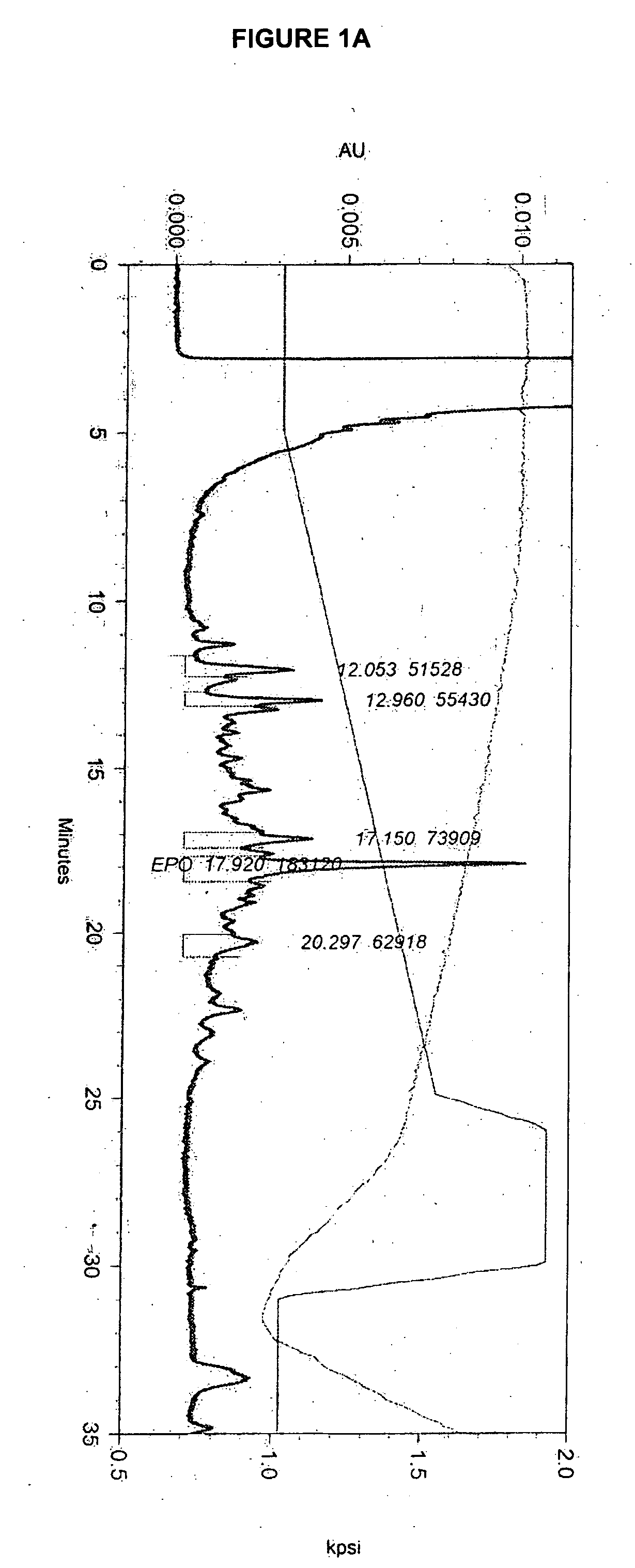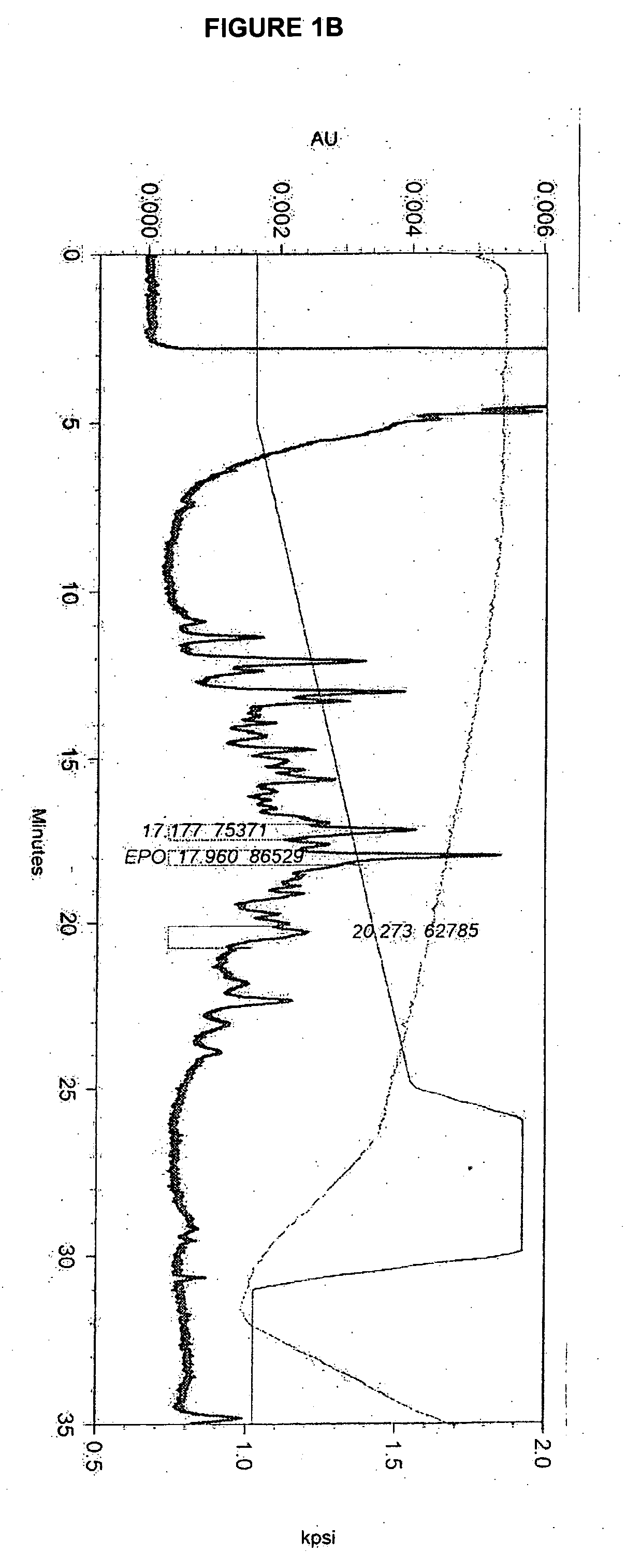Manufacturing process for the production of peptides grown in insect cell lines
- Summary
- Abstract
- Description
- Claims
- Application Information
AI Technical Summary
Benefits of technology
Problems solved by technology
Method used
Image
Examples
example 1
Preparation of a Lipid Mixture for BEVS Expression
1.1 Preparation of Pluronic F-68 solution
[0204] A solution of Pluronic F-68 was prepared as follows: 800 mL of deionized H2O was stirred rapidly. 90 grams of Pluronic F68 were added to the stirred solution and the volume was adjusted to 900 ml with deionized H2O. In a covered container Pluronic F-68 was allowed to completely solubilize. After solublizing the Pluronic F-68, the solution was transferred to a 37° C. waterbath during preparation of the lipid mixture.
1.2 Preparation of a 100× Lipid Mixture
[0205] 100 mL of absolute ethanol was warmed to 37° C. while stirring in a covered container. Cholesterol was added to the ethanol, and solubilized. Tween 80 was added to the lipid solution next after the cholesterol, and acts to improve cholesterol solubility. The remaining components of the lipid mixture were then added. The components were added to the ethanol in the amounts indicated below in Table 2. Using a stir plate with a ...
example 2
Effects of Lipid Mixture Addition on EPO Production in Sf9 Insect Cell Cultures
[0209] The effect of lipid supplementation on the production of erythropoetin (EPO) was investigated. A commercially available, chemically defined lipid concentrate was compared to the fresh lipid mixture prepared as discribed in Example 1. The fresh lipid mixture was added to the cell culture at 0%, 1.0% and 1.5% v / v. The data shows that the fresh lipid mixture added at the time of infection produced EPO titers in Sf9 cell cultures that were 38% higher than those from cultures supplemented with the commercial lipid mixture. The study also demonstrated that 1.5% lipid supplementation yields an EPO titer that is 82% higher than the control (no lipid addition) and 35% higher than the 1.0% supplementation. Both lipid preparations supplemented at 1.5% produced a cleaner cell culture broth and higher quality EPO. It was also observed that when either lipid mix was added, the drop in cell viability through inf...
experiment 2a
[0231] 2 liters (L) Sf9 cells with VCD of 4.7×106 cells / mL and viability of >90% were transferred to fermenter Z-1100H containing 5 liters Sf-900II media. After 4 days, when VCD=6.29×106 cells / mL and viability=78.5%, 100 mL yeastolate was added to increase VCD. The following day, when VCD=8.04×106 cells / mL and viability=74.3%, 225 mL fresh lipid mix (prepared according to the protocol in Example 1) was added aseptically through the 19mm head port / septum on Z-1100H septum to give a final lipid mix addition of 1.5%. Cells were allowed to acclimate to the lipid mix for 1 h. After 1 h, the cells were infected with 200 mL concentrated virus (titer=5.22×107 pfu / mL as determined by the standard plaque assay). An additional 7 L Sf-900II media was added after infection. The run parameters are outlined in the Table 5 below.
TABLE 5Summary of Parameters for Experiment 2APre-Infection ParametersAgitation (rpm) / Impellor Type80 / marineAeration (lpm)0.3Temperature (° C.)27.5DO Setpoint (%)60Post-I...
PUM
| Property | Measurement | Unit |
|---|---|---|
| Fraction | aaaaa | aaaaa |
| Fraction | aaaaa | aaaaa |
| Fraction | aaaaa | aaaaa |
Abstract
Description
Claims
Application Information
 Login to View More
Login to View More - R&D
- Intellectual Property
- Life Sciences
- Materials
- Tech Scout
- Unparalleled Data Quality
- Higher Quality Content
- 60% Fewer Hallucinations
Browse by: Latest US Patents, China's latest patents, Technical Efficacy Thesaurus, Application Domain, Technology Topic, Popular Technical Reports.
© 2025 PatSnap. All rights reserved.Legal|Privacy policy|Modern Slavery Act Transparency Statement|Sitemap|About US| Contact US: help@patsnap.com



